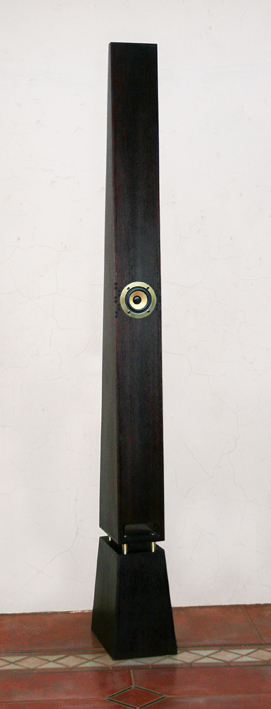
hi-fi innovation
"the devil's in the details"
Is this a Loudspeaker?

About two years ago a tiny amplifier arrived in the mail. It was the Sonic Impact T-Amp, a sandwich-sized 10 Watt one-knob-and-LED amplifier that had the audiophile world a-stir. Immediately it was hooked up to a pair of high-end bookshelf monitors and the listening began. Soon the realisation dawned that the T-Amp simply would not be able to drive a loudspeaker of 81dB/Watt sensitivity. Some plan had to be made.
An extended web-trawling session for loudspeakers with higher sensitivity happened upon The Single Driver Web Site. Somehow something had changed: a tremendous amount of scepticism informed by cheap boom boxes, each inhabited by a solitary loudspeaker driver with a whizzer cone and a plastic foil dust cap, had given way to strange excitement. Can a single driver really produce hi-fi sound?
Some time later a few slabs of MDF arrived and an end-of-the-line midrange driver was purchased. Not long after two gawky one-eyed objects stood in front of the T-Amp. Expecting no bass and copious amounts of intermodulation distortion, the sound out of these two speakers came as quite a surprise. Certainly they had very little high treble, but their sound was surprisingly pure and possessed a kind of liveliness not previously encountered. And this from a measly midrange that never claimed to be any kind of fullrange device.
A lot of water has passed under the bridge since then. The midrange driver has given way to many drivers. The treble was fixed. Finally a 75mm Kevlar pro-driver was chosen and after hundreds of simulations, adjustments and listening tests the Φ58.40 rose from the sawdust. And with it, PHI Hi-Fi Innovation was born.
But why one driver when the frequency can be split between two or more highly capable drivers? Surely the reduced amount of stress on each driver will produce greater purity of sound? In a perfect world perhaps, but "splitting" the frequencies between drivers introduces problems that are well nigh impossible to avoid. Not least of which is the phase distortion produced by the crossover, delaying some frequencies more than others and giving the sound an unnatural pallor. In addition the drivers have differing tonal "signatures" that do not integrate into a believable whole. By sidestepping these, and many other pitfalls, the single driver loudspeaker has an unequalled immediacy and presence, traits that no audiophile should allow to disappear from sound reproduction.
The loudspeaker enclosure of choice at PHI is the Tapered Quarter Wave Pipe, also known as the Voigt Pipe. Designed in the 1950's it steadily lost favour as more powerful amplifiers came into existence and the need for high sensitivity loudspeakers disappeared. Thus the hi-fi world was cheated out of a very special loudspeaker design, making way for an endless succession of same-sounding bass-reflex boxes. Fortunately a few companies have rediscovered this design, modifying the dated principles for optimising these pipes and re-introducing them to the hi-fi market. We believe that we have brought this design to a level of quality never attained before.
Please allow us to open your ears to what can be.
Jacques van Zyl
For any information, please contact us
Home Philosophy News New Pictures Products Cyclops Contact Who are we?